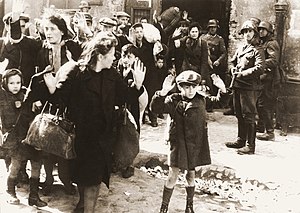The Warsaw Ghetto Uprising
| Warsaw Ghetto Uprising | |||||||
|---|---|---|---|---|---|---|---|
| Part of World War II and the Holocaust | |||||||
 Photo from Jürgen Stroop's report to Heinrich Himmler from May 1943 and one of the best-known pictures of World War II. The original German caption reads: "Forcibly pulled out of dug-outs." |
|||||||
|
|||||||
| Belligerents | |||||||
|
|||||||
| Commanders and leaders | |||||||
|
|||||||
| Strength | |||||||
| Daily average of 2,090 including 821 Waffen-SS | About 600 ŻOB and about 400 ŻZW fighters, plus a number of Polish fighters | ||||||
| Casualties and losses | |||||||
| 17 confirmed and up to 300 killed, 93 wounded (German figures) | About 13,000 killed, 56,885 deported, mostly civilians (German estimate) | ||||||
| According to Stroop's unofficial account, 71,000 people in all were killed or deported. The 16 killed on the German side do not include Jewish forced collaborators. | |||||||
The Warsaw Ghetto Uprising (Yiddish: אױפֿשטאַנד אין װאַרשעװער געטאָ; Polish: powstanie w getcie warszawskim; German: Aufstand im Warschauer Ghetto) was the 1943 act of Jewish resistance that arose within the Warsaw Ghetto in German-occupied Poland during World War II, and which opposed Nazi Germany's final effort to transport the remaining Ghetto population to Treblinka. The uprising started on 19 April when the Ghetto refused to surrender to the police commander SS-Brigadeführer Jürgen Stroop, who then ordered the burning of the Ghetto, block by block, ending on 16 May. A total of 13,000 Jews died, about half of them burnt alive or suffocated. German casualties are not known, but were not more than 300. It was the largest single revolt by Jews during World War II.
In 1939, German authorities began to concentrate Poland's population of over three million Jews into a number of extremely crowded ghettos located in large Polish cities. The largest of these, the Warsaw Ghetto, concentrated approximately 300,000–400,000 people into a densely packed, 3.3 km² central area of Warsaw. Thousands of Jews died due to rampant disease and starvation under SS-und-Polizeiführer Odilo Globocnik and SS-Standartenführer Ludwig Hahn, even before the mass deportations from the Ghetto to the Treblinka extermination camp began.
...
Wikipedia
